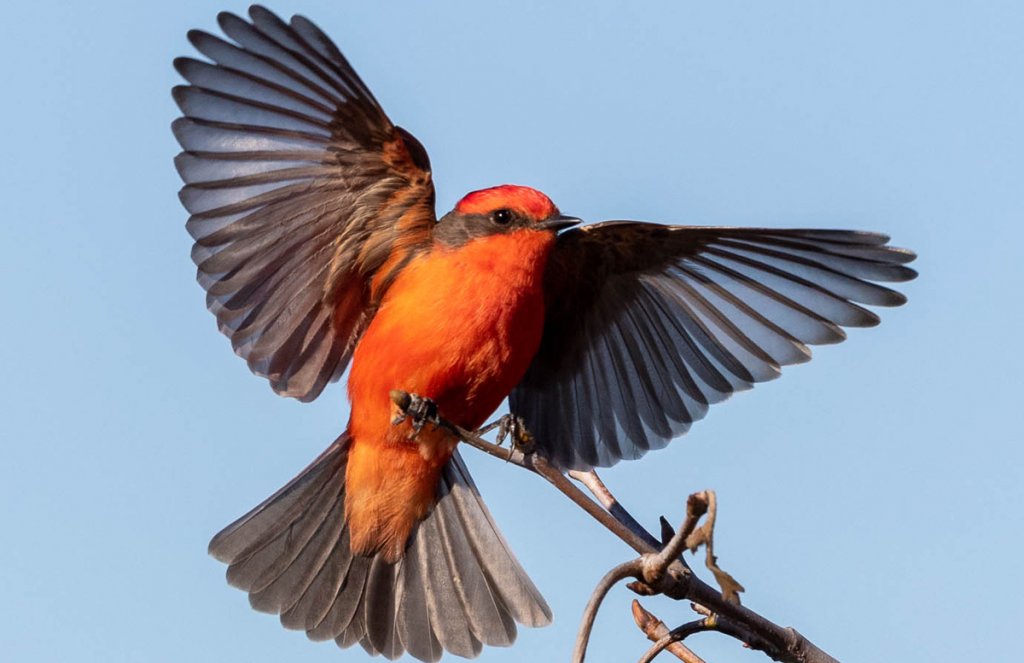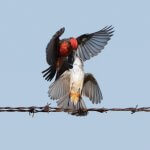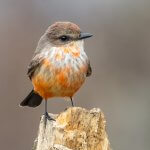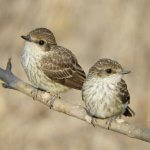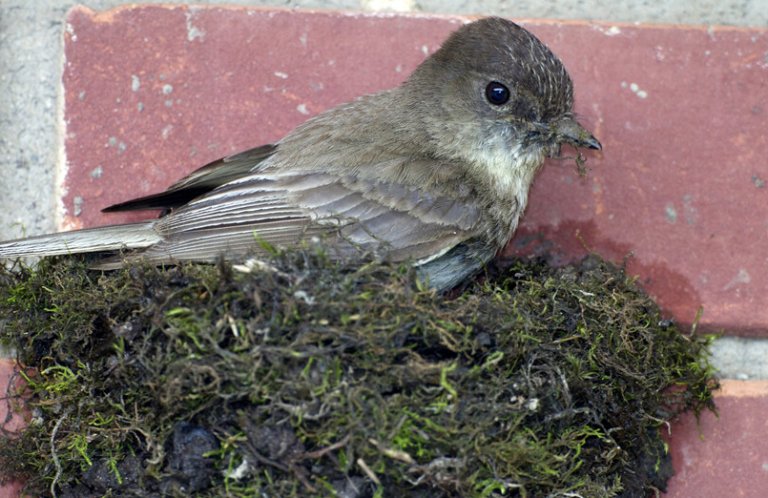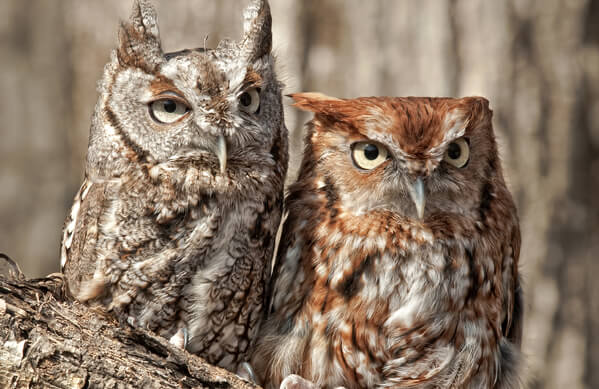About the Vermilion Flycatcher
The male Vermilion Flycatcher is a stunning standout within a family of rather drab relatives such as the Southwestern Willow Flycatcher and Eastern Phoebe. Its Latin name, “fire-headed ruby,” is a fitting description of the male's bright red head crest and underparts, which seem to glow as it flits through its sometimes-arid surroundings.
Male and female Vermilion Flycatchers are quite different in appearance, a trait known as sexual dimorphism. While the male is bright red with a brownish-black mask and dark brown back, wings, and tail, the female is more subtle, with light brownish-gray upperparts, whitish streaked breast, and red or yellow-shaded underparts.
This fiery little flycatcher has populations that occur from the southern U.S. all of the way to Argentina. But some aren't quite as red as others.
(Not) Simply Red
On the coast of Peru around Lima, some Vermilion Flycatchers have no red at all—they're a dusky brown. These birds are a morph (form) of this species. The dusky ones can come from the same nest as the bright red ones, the same way that the Eastern Screech-Owl can produce gray and red morphs in the same clutch. The brown “vermilion” flycatchers interact and breed with the red morphs, all as one species.
Songs and Sounds
Male and female Vermilion Flycatchers give sharp, high-pitched calls. The male sings a series of trilled phrases, p-p-p-pik-zee. During his aerial courtship display, the male sings variations of this song.
Listen here:
Calls:
Song:
Breeding and Feeding
Site Showings and Insect Incentives
Like the related Scissor-tailed Flycatcher, the male Vermilion Flycatcher performs an eye-catching aerial display, singing while ascending into the sky on fluttering wings. He also flies to potential nest sites while calling to nearby females, encouraging them to come take a look. To seal the deal, he will present the gift of a particularly colorful insect to a potential mate.
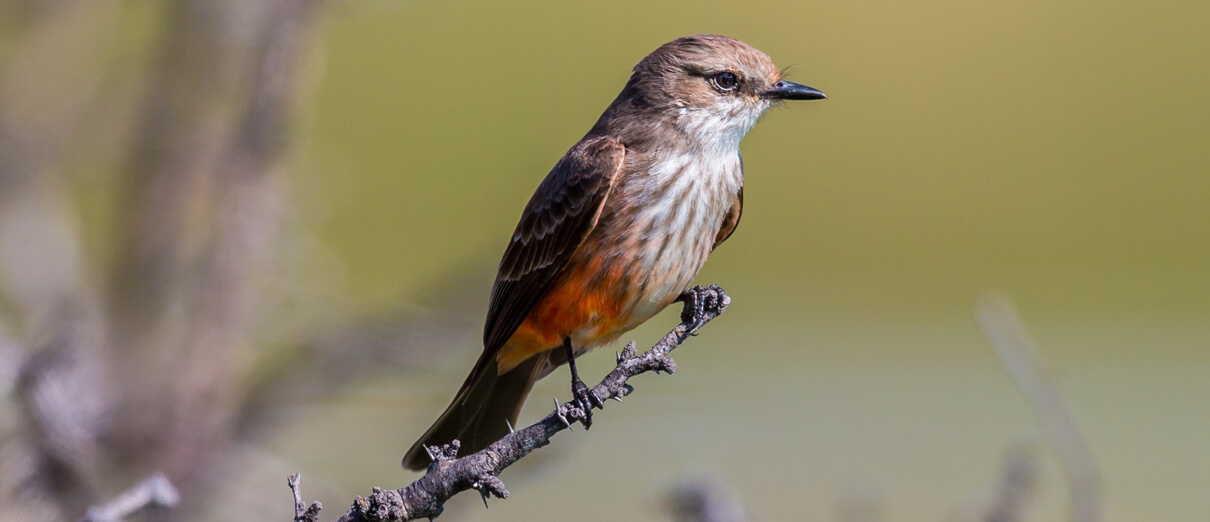
Once a female Vermilion Flycatcher consents to a partner, she selects the final nest site, usually in a riparian area. She builds her shallow cup nest in a mesquite, willow, sycamore, or similar shrubby tree, often near the water. The nest is built of twigs, grasses, and other vegetation, lined with softer materials such as feather down and hair. She lays 2-4 eggs, which she incubates alone for about two weeks. The male will bring his mate food while she's on the nest, then both parents feed the chicks after they hatch. This species usually produces two clutches per season, often reusing the same nest.
The Vermilion Flycatcher is as highly insectivorous as other members of its family, feeding upon a wide variety of arthropods, including grasshoppers, bees, beetles, crickets, and spiders. Like other flycatchers such as the Eastern Kingbird and Olive-sided Flycatcher, it employs a “sit and wait” hunting strategy; patiently perching until it spots prey, then darting out to capture it mid-flight with an often-audible snap of its bill.
Region and Range

This fiery little flycatcher reaches the northern limits of its distribution in the southwestern United States, but actually has an extensive range, reaching south from the United States through Mexico, Central America, and into, Ecuador, Peru, and Argentina.
The bright red flycatchers found on the Galapagos Islands were initially considered to be separate species, were then lumped with the mainland birds, and now are once again considered to be at least two distinct species: the Little Vermilion Flycatcher and the now-extinct Least Vermilion Flycatcher.
The Vermilion Flycatcher breeds in at least four separate regions. Populations at the northern and southern ends of its range are migratory. North American breeders winter south through Mexico and Central America, while other populations stay in place year-round.
Conservation
Loss of riparian habitat throughout the American southwest is a particular threat to the Vermilion Flycatcher in the U.S. and other birds of conservation concern such as the Western Yellow-billed Cuckoo, Costa's Hummingbird, Southwestern Willow Flycatcher, and Least Bell's Vireo.
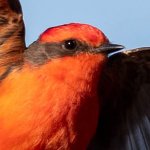
Help support ABC's conservation mission!
ABC is working to preserve this habitat on several fronts. We continue our advocacy for the San Pedro River, one of the last major undammed rivers in the American Southwest that runs through the Chihuahuan Desert and the Sonoran Desert in southeastern Arizona. ABC has also been working with landowners and managers at Texas's B. J. Bishop Wetlands and Sandia Springs Wetland Project to continue creating and safeguarding artificial and enhanced wetlands for birds and other wildlife.
Our BirdScapes program also protects important southwestern riparian habitats through the Rio Grande Joint Venture, which works in a variety of priority bird habitats and working lands for a suite of migratory and resident birds.
Migratory and resident populations of Vermilion Flycatcher are also widespread throughout ABC's Reserve Network, recorded at over 25 of these protected areas.
Get Involved
Policies enacted by the U.S. Congress and federal agencies, such as the U.S. Fish and Wildlife Service, have a huge impact on migratory birds. You can help shape these rules for the better by telling lawmakers to prioritize birds, bird habitat, and bird-friendly measures. To get started, visit ABC's Action Center.
Living a bird-friendly life can have an immediate impact on migratory birds in the United States. Doing so can be as easy as adding native plants to your garden, avoiding pesticides, and keeping cats indoors. To learn more, visit our Bird-Friendly Life page.
American Bird Conservancy and our Migratory Bird Joint Venture partners have improved conservation management on more than 8.5 million acres of U.S. bird habitat — an area larger than the state of Maryland — over the last ten years. That's not all: With the help of international partners, we've established a network of more than 100 areas of priority bird habitat across the Americas, helping to ensure that birds' needs are met during all stages of their lifecycles. These are monumental undertakings, requiring the support of many, and you can help by making a gift today.





































